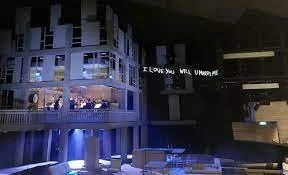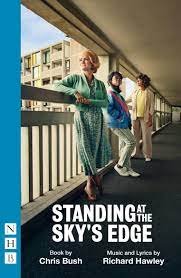STANDING AT THE SKY'S EDGE AT THE NATIONAL THEATRE
Professor Ivor Smith of Cambridge University Architecture School designed Park Hill flats. He would have loved to see his creation, the largest social housing scheme in Europe, make it to the stage of the National Theatre. so many decades after its triumphant opening . This is a story of the people who lived in these ‘streets in the sky’ as the layers of Park Hill were known, ‘ wide enough to get a milk float through’ was the order.
Musicians and players on the fabulous set
Drawn from the slums of Sheffield many of the first generation of tenants felt they had arrived in heaven. And with its stunning views over the city, it must have felt as if they were Standing on the Sky’s Edge. One of the new tenants from an African family announces at one point with some wonder that he had been for a walk and seen a street named ‘Sky Edge Road’ Strangely I had lived there right at the top, for the first nine years of my life. I never thought to hear it mentioned in a Musical at the National Theatre.
The concept was Utopian. There was a community school, doctor, a housing officer and a police station built in.
Refugees are residents of the drama
Richard Hawley’s music makes a magical framework for this beautifully staged production. It has grown since its inception at the Crucible Theatre in Sheffield where the full cast numbered 14. There are 40 players in the National’s version, and a delightful small orchestra on one of the highest flats. They played almost throughout the play. Yes, there were islands of well -crafted conversations, but the music soared through the lovely space of the Olivier auditorium – and the songs and singing were brilliant. Within moments the audience relaxed into this new piece and handed over their hearts to a story of generations who tried to rise, got shot down and went on to try another day.
The amazing set
Not all of them. This is a production with something to say, it is political in the best sense of the word. Here were people from an ebullient newly-wed who announced he was ‘ the youngest foreman in the steelworks’ to the refugees who came to love their neighbours. The play is structured around three general elections, it moves forward and back in time, between the hopefulness of the earliest years through to the destruction wrought in 1992 with the consolidation of the Thatcher government. Soon the famous edifice that was Sheffield fell, literally in the case of Park Hill. But Standing at the Sky’s Edge was full of hope – despite personal tragedy – expressed in the creativity of the cast and their author, the music and its composer, the energy of the people and their memory.
This is an epic production original and fresh with something to say – for today.










